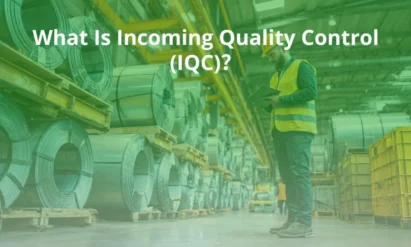A Comprehensive Guide to Manufacturing Audits
Jul 08,2025

Manufacturing audits are an important tool for evaluating and improving manufacturing processes, ensuring product quality, maintaining regulatory compliance, and improving overall operational efficiency.
Whether you are a business owner, quality control manager, or supply chain professional, understanding the importance and nuances of manufacturing audits will have a significant impact on your company’s success.
This guide will take you through all aspects of manufacturing audits, including their types, benefits, processes, and best practices.
What Is a Manufacturing Audit?
A manufacturing audit is a systematic examination of a company’s manufacturing processes, procedures, and facilities. Its goal is to assess compliance with established standards, identify inefficiencies, evaluate production quality, and ensure that products are produced in a manner that complies with regulations, safety standards, and customer expectations.
Manufacturing audits are typically performed by external auditors or internal quality assurance teams who review documents, check processes, and evaluate the overall operation of the facility.
Manufacturing audits can be conducted at various stages of production, from initial setup and material procurement to final product assembly. These audits can be planned or unplanned and may be necessary for various certifications such as ISO, FDA, UL, or other industry-specific standards.
Who Conducts a Manufacturing Audit?
Manufacturing audits may be conducted by:
- First-party (internal): Audits performed by the factory’s own team.
- Second-party (customer/buyer): Audits performed by the buyer to verify the supplier’s capability.
- Third-party (independent): Audits by external firms like QCC INSPECTION offer an unbiased evaluation.
Third-party audits are especially useful for importers and brands that need reliable information without physically visiting the factory.
What Are the Different Types of Factory Audits?
Manufacturing audits come in different forms, each with its own purpose and scope. The most common types include:
Factory Capability Audit
Verifies whether the supplier has the right resources, equipment, and processes to meet your production requirements.
Quality System Audit
Quality audits assess the quality control systems in place and whether the manufacturing processes consistently produce products that meet the required specifications. These audits typically examine production techniques, material handling, testing procedures, and inspection methods.
Social Compliance Audit
These audits focus on ensuring that manufacturing processes comply with relevant laws, regulations, and industry standards. This may include environmental regulations, workplace safety standards, and product safety requirements. For instance, a facility producing electrical equipment might undergo an audit to ensure compliance with UL standards.
Environmental Audit
Environmental audits focus on ensuring that the manufacturing facility operates in an environmentally sustainable manner. This may involve compliance with waste management, emissions, water usage, energy consumption, and other environmental regulations.
Structural and Fire Safety Audit
These audits ensure that manufacturing facilities adhere to workplace safety standards, including OSHA guidelines. They evaluate potential hazards, worker safety protocols, emergency preparedness, and overall safety culture within the facility.
Supplier Audits
Supplier audits focus on evaluating the performance of suppliers or subcontractors that provide raw materials, components, or services for your production process.
This audit ensures that suppliers meet the required quality, delivery, and compliance standards, thereby reducing the risk of defects or delays in your supply chain.
Security Audit
Focuses on cargo and supply chain security, often tied to C-TPAT or similar programs.
Process Audit
These audits evaluate the efficiency and effectiveness of a specific manufacturing process. The goal is to identify bottlenecks, inefficiencies, waste, or any other areas for improvement. Process audits can help optimize production flow, reduce costs, and improve productivity.
When Should You Conduct a Factory Audit?
Factory audits are most valuable when conducted at critical moments, such as to verify the legitimacy and capabilities of a new supplier before engaging with it, to monitor its performance through routine audits during an ongoing relationship, to investigate quality issues, delays or complaints after they arise, to ensure readiness and compliance before a critical order or market launch, and as part of regular risk management, particularly in high-risk countries or volatile industries.
Benefits of Auditing the Manufacturing Process
Manufacturing audits offer a variety of benefits that can improve a company’s operations, reputation, and bottom line. Some of the most notable benefits include:
Improved Product Quality: Regular audits help ensure that products meet customer expectations and regulatory requirements. By identifying defects, inefficiencies, or weaknesses in the production process, manufacturers can take corrective action before products reach the market.
Enhanced Compliance: Compliance audits help companies ensure that they are following industry regulations and standards, reducing the risk of legal issues or penalties. Adherence to these standards can also make it easier to obtain necessary certifications or approvals for certain markets.
Cost Reduction: Audits often reveal areas of inefficiency or waste that may not be immediately apparent. By optimizing manufacturing processes, companies can reduce operational costs, improve resource utilisation, and increase profitability.
Increased Efficiency: Process audits help identify bottlenecks or areas of slowdowns in the production line. By resolving these issues, manufacturers can increase production speed, reduce lead times, and meet demand more effectively.
Stronger Supplier Relationships: Supplier audits help ensure that raw materials and components meet the necessary quality standards, preventing delays and defects in the supply chain. Regular supplier audits can lead to stronger relationships and better communication between manufacturers and their suppliers.
Continuous Improvement: Manufacturing audits encourage a culture of continuous improvement. Regular audits provide valuable feedback that can be used to make ongoing adjustments and improvements to production processes, quality control procedures, and employee training.
Risk Mitigation: Audits help identify potential risks before they become major problems. Whether it’s compliance issues, quality concerns, or safety hazards, audits provide the opportunity to address risks proactively, reducing the likelihood of costly recalls or legal liabilities.
What Are the Key Stages of a Factory Audit?
A complete audit typically involves three main phases: the pre-audit phase, where the audit scope is defined, previous reports are reviewed, a checklist is planned, and schedules are coordinated; the on-site audit phase, which includes conducting physical inspections, interviewing staff, examining records, and photographing findings; and the post-audit phase, where a report is delivered, non-conformities are outlined, corrective actions are recommended, and follow-up is conducted if necessary.
What Should You Include in a Factory Audit Checklist?
While each audit may differ, a typical checklist includes:
- Business licenses and certifications
- Production capability and equipment
- Quality control processes
- Raw material and component sourcing
- Staff training and labor conditions
- Fire safety and emergency readiness
- Environmental practices (waste, energy use)
Advanced Tips for Achieving Audit Excellence
To optimize your audit process, leverage technology by using mobile apps for real-time reporting and data collection, train your audit team to keep them updated with industry standards, and foster transparency by sharing reports clearly with suppliers to encourage collaboration.
Additionally, promote a quality culture by positioning audits as tools for improvement rather than punishment, and use audits as part of a continuous improvement strategy, not just as a box-ticking exercise.
How QCC INSPECTION Helps You with Factory Audits in China
QCC INSPECTION is an experienced third-party audit and inspection firm.
We provide:
- Pre-audit consulting and supplier screening
- On-site audits across China and Southeast Asia
- Detailed, photo-rich reports within 48 hours
- Custom checklists tailored to your standards (ISO, social, safety, etc.)
Whether you’re sourcing from China or expanding your vendor base, QCC can help you reduce risks, verify capabilities, and ensure consistent product quality.
FAQs About Manufacturing Audits
Q: How often should a manufacturing audit be done?
A: At least annually, more often for high-risk suppliers or changing environments.
Q: Can I customise the audit scope?
A: Yes, most professional audit firms like QCC offer tailored checklists.
Q: How long does a factory audit take?
A: Typically 1 working day per factory, depending on size and complexity.
Q: Will I receive a report?
A: Yes. QCC provides a structured audit report with photos and actionable recommendations.
--- END ---
Products
Get A Free Quote
Related Blogs
QCC SAMPLE REPORT
For sample reports or custom checklists, please contact us – we're here to assist you.


 November 28,2025
November 28,2025

